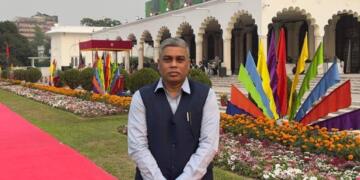The sacred city of Prayagraj is expected to welcome millions of pilgrims, saints, and tourists in the upcoming Maha Kumbh Mela 2025, that is set to take place from January 13 to February 26, 2025.
The Maha Kumbh Mela is not just a dharmic occasion but is a testament of India’s rich spiritual legacy. Another name for the festival is Purna Kumbh. It is considered to be the world’s largest human congregation. Additionally, during the 12th session of UNESCO which was held in December 2017 in Jeju, South Korea, it recognized the Kumbh Mela as the Intangible Cultural Heritage of Humanity.
This has further increased awareness of the dharmic occasion on a global scale. It is an intriguing fusion of social interaction, religion, and recreational activities that has been celebrated for many centuries.
In Sanskrit, “Kumbh” means Pitcher and “Mela” means fair. According to dharmic puran, after a protracted conflict between Gods and the Demons which lasted for 12 days and 12 nights, the nectar of immortality (Amrit) was poured from a pitcher on four different locations in India, they are Prayagraj, Haridwar, Nasik and Ujjain.
The Kumbh Mela in its different forms alternates between these locations. It takes places once every three years in the banks of the rivers—the Ganga in Haridwar, the Godavari in Nasik, the Kshipra in Ujjain, and the Sangam (the confluence of the Ganga, Yamuna, and Saraswati rivers) in Prayagraj.
The Ardha (half) Kumbh is celebrated every six years whereas the Purna (full) Kumbh is celebrated every 12 years.
The Sacred Rituals
The Sangam, where the rivers converge in Prayagraj, is extremely auspicious. It is believed that one dip in the Sangam River during Kumbh Mela can atone for all sins. In addition to attending dharmik katha and discussions on Purana in camps called “Akharas,” pilgrims primarily worship at temples and take holy dips or ritual baths on auspicious days (Shahi Snan).
The length of the festival determines how many auspicious days there are in total. Nearly 100 million people attended the 55-day festival in Prayagraj in 2013, which included six significant bathing days.
A focus group study found that people attended in order to gain spiritual knowledge and to connect with others. It serves as a forum for people to unite regardless of their religious beliefs.
The visitors range from sadhus, Hindu devotees to tourists (mostly from India, but also from other countries) who come to experience the event and take holy dip.
The festival officially begins on Peshwai, when all of the sadhus and Mela attendees are welcomed as guests. After a large procession filled with boisterous music and dancing, the mass feeding of guests takes place at Langar. The cuisine is vegetarian.
A group of sadhus known as naga sadhus, who are regarded as the most powerful of all in both spiritual and physical abilities, initiate the bathing ritual, which is the most significant of all. As ardent devotees of Bhagwan Shiv, they have renounced all worldly belongings, including clothing, wealth, and family. As a sign of divine protection, they bathe in ash and apply it all over their bodies. They are also usually naked, except sometimes in loin cloth.
Thousands of followers aspire to become Naga Sadhus during each Kumbh Mela, and they are accepted into the group after a covert initiation procedure. Following the initiation, they ritually shave their heads to symbolize their renunciation of the materialistic body and death of one’s self. They then begin the bathing ritual for everyone at dawn the following day after chanting mantras through the night. The other millions of pilgrims are permitted to enter the water (ghat) after the sadhus have taken a dip in the sacred waters. Additionally, the sadhus conduct ceremonies on a variety of boats, and an offering—such as flowers, coconuts, or garlands—is placed in the river.
Other than these, the city is filled with religious talks, vedic chants, and pujas. To illustrate diversity, there are also cultural performances from various regions. Pilgrims are allowed to follow any leader they choose and travel anywhere. Neither the number of days required to attend the Mela nor the requirement to take the sacred dip in the river are set in stone. A group of people known as Kalpawasis endure harsh conditions during the Mela, including freezing winter temperatures and living in tents without heating systems.
The building of the Mela city starts two to three months prior to the festival commencement. The structure is made to accommodate over 80 million pilgrims who come and go from the festival grounds, as well as over a million “permanent” Mela attendees who stay for the whole time. There are tents all over the city, and each group of tents, known as an akhara, is owned by a preacher or religious saint and is registered with a central government agency. Ceremonial halls, temples, and other activities take up the remaining space.
Given the size of the crowd, there are significant and varied risks including that of chaos, and stampede but the management have always ensured the religious gathering continue smoothly without any untoward incident.
The Kumbh Mela is more than just a religious gathering. People from all walks of life are drawn to it because it is a potent symbol of India’s spiritual and cultural legacy. A powerful reminder of human devotion, community, and the pursuit of spiritual enlightenment is provided by the gathering of millions at the holy confluence of rivers.

































